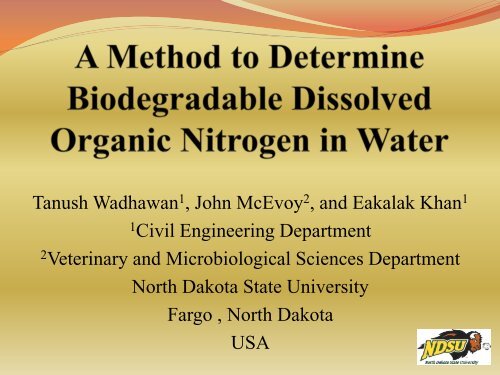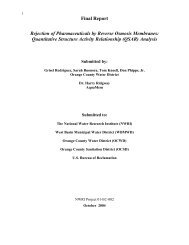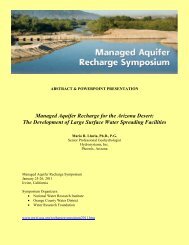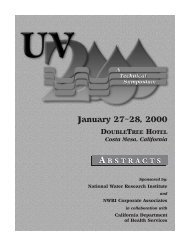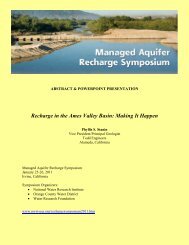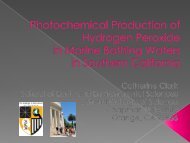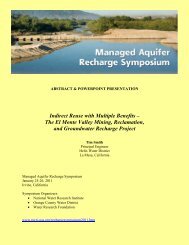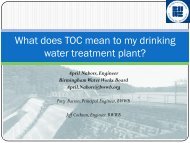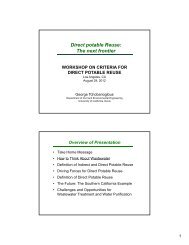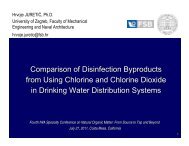A Method to Determine Biodegradable Dissolved Organic Nitrogen ...
A Method to Determine Biodegradable Dissolved Organic Nitrogen ...
A Method to Determine Biodegradable Dissolved Organic Nitrogen ...
You also want an ePaper? Increase the reach of your titles
YUMPU automatically turns print PDFs into web optimized ePapers that Google loves.
Tanush Wadhawan 1 , John McEvoy 2 , and Eakalak Khan 1<br />
1<br />
Civil Engineering Department<br />
2<br />
Veterinary and Microbiological Sciences Department<br />
North Dakota State University<br />
Fargo , North Dakota<br />
USA
Outlines<br />
•Introduction<br />
•Research justification and objective<br />
•<strong>Method</strong>ology<br />
•Results and discussion<br />
•Conclusions<br />
•Ongoing work<br />
•Acknowledgements
Introduction<br />
• <strong>Dissolved</strong> organic carbon (DOC) and dissolved<br />
organic nitrogen (DON) are parts of natural organic<br />
matter (NOM).<br />
• DOC = <strong>Biodegradable</strong> DOC (BDOC) + Non-BDOC<br />
• BDOC = DOC that can be mineralized by bacteria.<br />
• BDOC in finished water can support undesirable<br />
bacterial growth in water distribution system.
Introduction<br />
• DON = <strong>Biodegradable</strong> DON + Non-BDON<br />
(BDON)<br />
(NBDON)<br />
• BDON = DON that can be mineralized<br />
(ammonified) by bacteria.<br />
• BDON in finished water can support undesirable<br />
bacterial growth in the water distribution system.<br />
• BDON could lead <strong>to</strong> nitrification.<br />
<strong>Organic</strong> N NH 3 -N NO 2 -N NO 3 -N
Introduction<br />
• To prevent bacterial regrowth, treatment plants<br />
add disinfectants such as chlorine or chloramines.<br />
• Disinfectants + NOM disinfectant by-products<br />
(DBPs).<br />
• Trihalomethanes and haloacetic acids are the<br />
common DBPs.<br />
• But focus has shifted <strong>to</strong>wards nitrogen containing<br />
DBPs including haloace<strong>to</strong>nitriles,<br />
halonitromethanes, haloacetamide and<br />
nitrosoamines.
Introduction<br />
• N-DBP formation from DON in the presence of<br />
hypochlorite, monochloramines and chlorine gas<br />
has been reported.<br />
• BDON or NBDON is a precursor for N-DBP?<br />
• This knowledge will help in controlling formation<br />
of N-DBPs in treatment plants.<br />
• Controlling BDON in finished water will help in<br />
minimizing nitrification.
Research Justification<br />
• Before being able <strong>to</strong> control BDON (or NBDON),<br />
need <strong>to</strong> be able <strong>to</strong> determine it.<br />
Objective<br />
• To develop a method for measuring BDON in<br />
water.
<strong>Method</strong>ology<br />
• Adopted from the BDON test for wastewater.<br />
• BDON in wastewater can reduce oxygen and<br />
support algal growth in receiving waters.<br />
• The method was based on the ability of bacteria <strong>to</strong><br />
ammonify DON.<br />
• DON reduction before and after incubation with<br />
mixed culture inoculum.
<strong>Method</strong>ology<br />
• BDON measurement in wastewater is easier than<br />
in drinking water.<br />
• The concentration of organics in drinking water is<br />
very low.<br />
• Finding correct type of inoculum.<br />
• Finding adequate incubation time.<br />
• Finding sensitive analytical methods for<br />
nitrogen determination.
<strong>Method</strong>ology<br />
DON = TDN – DNH 3 -N – DNO 2 -N – DNO 3 -N<br />
DON = DTKN – DNH 3 -N<br />
TDN = Total dissolved nitrogen<br />
DTKN = <strong>Dissolved</strong> <strong>to</strong>tal Kjehldahl nitrogen<br />
D = <strong>Dissolved</strong>
Water sample (300 mL)<br />
0.22 µm pore size membrane filter<br />
Filtrate DON measurement (DON i<br />
)<br />
2 mL<br />
inoculum 20°C and aerated every 12 hrs<br />
of 5%<br />
diluted Incubation<br />
MLSS bottle<br />
Sacrificed at 2, 7, 14, 21 and 28<br />
days<br />
DON measurement (DON f<br />
)<br />
BDOC was also measured.
<strong>Method</strong>ology<br />
• No direct method <strong>to</strong> measure DON.<br />
• DON = TDN – DNH 3 -N – DNO 2 -N – DNO 3 -N<br />
Sulfanilamide Napthylethylenediamine<br />
DNO 2 -N<br />
Diazo compound<br />
Colored azo dye<br />
543 nm<br />
0.01-2.5 µg/l
<strong>Method</strong>ology<br />
DNO 3 -N<br />
DNH 3 -N<br />
(Cd-Cu reduction)<br />
0.05-45 µg/l<br />
(Oxidized with NaClO in alkali)<br />
0.04-10 µg/l<br />
DNO 2 -N<br />
TDN<br />
(Oxidized with K 2 S 2 O 8 )<br />
2.0-40 µg/l<br />
DNO 3 -N
<strong>Method</strong>ology<br />
• BDON = [(DON i – DON f )]<br />
• BDON 2 = [(DON 0 – DON 2 )]<br />
• BDON 7 = [(DON 0 – DON 7 )]<br />
• BDON 14 = [(DON 0 – DON 14 )] …
<strong>Method</strong>ology<br />
• Samples from Moorhead Water Treatment Plant<br />
(WTP), Moorhead, Minnesota.<br />
• 4.1 MGD.<br />
• Three sets of samples collected three consecutive<br />
weeks.<br />
• Triplicate analyses.
Red River 1 Coagulating/<br />
Well 3 Softening Unit<br />
2 4<br />
Reservoirs<br />
8<br />
Distribution<br />
System<br />
9<br />
Moorhead WTP<br />
7<br />
Clear Well<br />
6<br />
Ozone<br />
Chamber<br />
5<br />
Biological<br />
Filters<br />
3, 4, 5 and 6 - Sampling locations
Coagulated and Softened Water<br />
Characteristics<br />
Parameters Average±standard deviation Range<br />
DOC (mg/L) 4.18±0.60 3.43-5.48<br />
UV absorbance at 254 nm (1/cm) 0.043±0.004 0.037-0.054<br />
Specific UV absorbance (L/mg<br />
1.04±0.18 0.75-1.45<br />
C.m)<br />
<strong>Dissolved</strong> oxygen (mg/L) 8.91±0.08 8.83-9.04<br />
Alkalinity (mg/L as CaCO 3 ) 70.05±12.35 42-94<br />
Hardness (mg/L as CaCO 3 ) 89.73±6.83 76-110<br />
pH 11.21±0.25 10.63-11.67<br />
Turbidity (NTU) 0.10±0.02 0.07-0.13
TDN (mg/L)<br />
Results<br />
TDN through incubation<br />
1.46<br />
1.44<br />
1.42<br />
1.40<br />
1.38<br />
1.36<br />
1.34<br />
1.32<br />
1.30<br />
0 10 20 30<br />
Incubation time (days)<br />
River<br />
Before ozonation<br />
After ozonation<br />
Treated effluent
TDN (mg/L)<br />
Results<br />
TDN<br />
1.50<br />
1.45<br />
1.40<br />
1.35<br />
1.30<br />
1.25<br />
1.20<br />
River<br />
Before<br />
ozonation<br />
After ozonation Treated effluent
DON (mg/L)<br />
Results<br />
River<br />
0.94<br />
0.93<br />
0.92<br />
0.91<br />
0.90<br />
0.89<br />
0.88<br />
0.87<br />
0 5 10 15 20 25 30<br />
Incubation time (days)
DON (mg/L)<br />
Results<br />
Before ozonation<br />
0.59<br />
0.58<br />
0.58<br />
0.57<br />
0.57<br />
0.56<br />
0.56<br />
0.55<br />
0 5 10 15 20 25 30<br />
Incubation time (days)
DON (mg/L)<br />
Results<br />
After ozonation<br />
0.61<br />
0.60<br />
0.59<br />
0.58<br />
0.57<br />
0.56<br />
0.55<br />
0 5 10 15 20 25 30<br />
Incubation time (days)
DON (mg/L)<br />
Results<br />
Treated effluent<br />
0.44<br />
0.44<br />
0.44<br />
0.43<br />
0.43<br />
0.43<br />
0.43<br />
0.43<br />
0.42<br />
0 5 10 15 20 25 30<br />
Incubation time (days)
BDON (ug/L)<br />
Results<br />
BDON<br />
60.0<br />
50.0<br />
40.0<br />
30.0<br />
River<br />
Before ozonation<br />
After ozonation<br />
Treated effluent<br />
20.0<br />
10.0<br />
0.0<br />
0 2 7 14 21 28<br />
Incubation time (days)
BDOC (mg/l)<br />
Results<br />
BDOC<br />
1.2<br />
1.0<br />
0.8<br />
Influent<br />
Before ozonation<br />
After ozonation<br />
Treated effluent<br />
0.6<br />
0.4<br />
0.2<br />
0.0<br />
2 7 14 21 28<br />
Incubation time (days)
Conclusions<br />
• A method for determining BDON in water was<br />
developed.<br />
• The method was based on DON reduction during<br />
incubation with mixed bacterial culture.<br />
• DON was determined based on the difference<br />
between TDN and inorganic nitrogen species<br />
combined.<br />
• To determined DON, nitrogen species involved<br />
were converted <strong>to</strong> NO 2 -N.
Conclusions<br />
• Incubation time of 14 days is adequate.<br />
• The developed method was successfully tested<br />
with water samples.<br />
• More work on the limitations of the method.
Ongoing Work<br />
• Using standard organic nitrogen samples <strong>to</strong><br />
determine:<br />
• Detection limit<br />
• Accuracy<br />
• Precision<br />
• Using pure culture inoculum:<br />
• Pseudomonas putida KT2440
Acknowledgments<br />
• Kris<strong>to</strong>fer Knutson – Moorhead Water Treatment<br />
Plant<br />
• Ruchi Joshi – Undergraduate Research Assistant<br />
• Halis Simsek – Ph.D. Candidate<br />
• Murthy Kasi – Ph.D. Candidate
Thank you.<br />
Questions?<br />
E-mail: eakalak.khan@ndsu.edu


